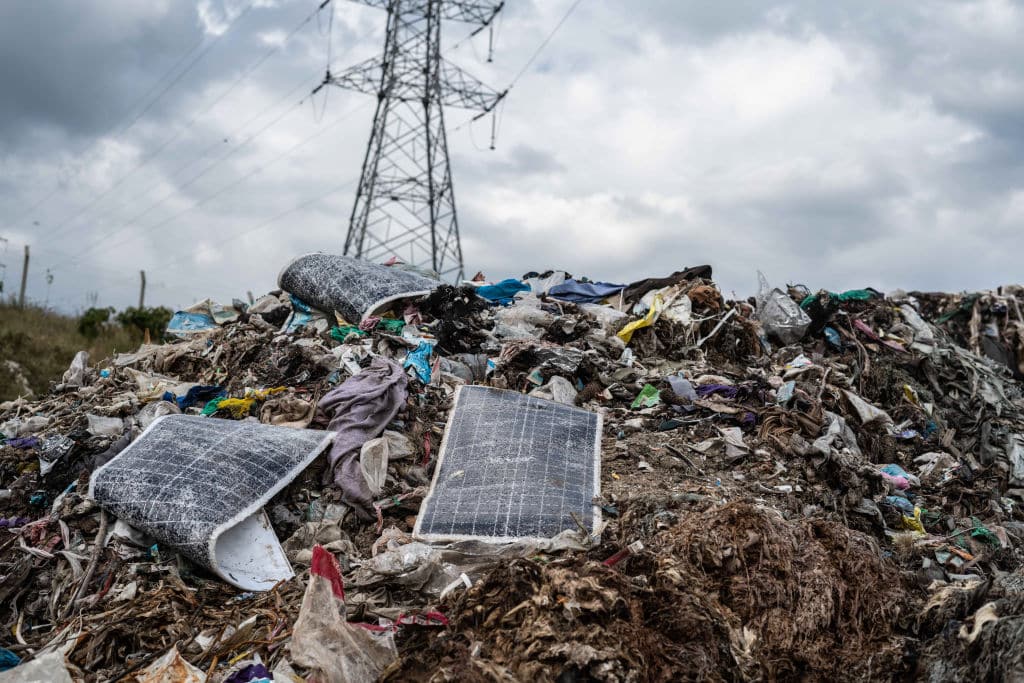The time to plan for the sudden influx of aged and dated solar materials is now– Africa can’t afford to become a toxic dumping ground for the e-waste detritus left behind by solar.
Over the past few years, Africa’s corporates and consumers went solar at an unprecedented speed. Statista found that as of the end of 2022, South Africa was in the lead with more than 6 gigawatts followed by Egypt (1.7 gigawatts), Morocco with 858 megawatts, Algeria with 460 megawatts and Senegal at 263 megawatts. The total gigawatts across the continent have increased significantly over the past 10 years from only 331 megawatts in 2011 to 12.6 gigawatts in 2022 – a 16-fold capacity increase. Burkina Faso, Cameroon and Tanzania are currently expected to see the most rapid transitions to clean energy by 2030, while Namibia’s growth is the fourth-fastest in the world as per research group Zero Carbon Analytics’ 2023 report Africa’s Energy Transition: Solar and Wind Fuel Energy Security.
The region is gaining traction. Research from the above report found that deployment of solar energy is the fastest-growing resource on the continent and accounted for 57% of renewable investments between 2010 and 2021. Investments in the off-grid sector were the highest in Africa over a similar 10-year period (2010-2020) at 70% and a value of $1.7 billion. When this level of investment is wedded to the life-span of the technologies used to power solar panels and farms, there’s another question companies and governments should be asking about solar – where’s the bin? If millions of solar panels and batteries are being imported into Africa, with a lifespan of around 20 years, what is being done to ensure that countries investing heavily in solar today are putting the right recycling plans in place?
“Typically, when we speak about solar waste, it includes solar panels, PV panels, inverters, solar PV batteries, rooftop solar frames, ground-based frames, junction boxes and embedded cables,” Mervin Olivier, Eastern Cape Chair at the Institute of Waste Man- agement of Southern Africa, tells FORBES AFRICA. “There’s a lot of solar waste and typically people just talk about the PV panel. As they reach end of life, thousands of panels will need replacing and recycling will become absolutely critical.”
The International Renewable Energy Agency has predicted that by 2050, 78 million metric tons of solar panels will reach the end of their lives. The issue is the toxicity of the materials within solar installations. Solar panels have lead, cadmium, silver, and arsenic that, at certain levels, are quantified as hazardous waste, the batteries used to power solar installations are lithium-ion phos- phate batteries which are flammable, and difficult to contain. The problem is that most solar panels and their detritus are dumped in landfills because there’s no profit in their ethical dismantling and destruction – the few precious metals locked within the e-waste are difficult to extract and their value too low for the effort.
Loading...
“Solar PV panels contain aluminium and glass which can be re- cycled, but the harmful chemicals in the batteries and the panels are difficult to recycle, which is why a lot of companies in Europe are sending them to countries in Africa, like Ghana, where they strip elements like copper out of the equipment and sell it,” Minnette Le Roux, Head of the Environment Department, Principal Environ- mental Specialist at law and consultancy advisory firm NSDV tells FORBES AFRICA.
“Then counties in Africa are left sitting with these massive amounts of hazardous waste. Some countries in Africa are part of the Basel Convention preventing the transport of waste but some are not part of the convention and accept the hazardous waste. There are no plants in Africa that actually recycle what’s left of the batteries – this is one of the biggest concerns – and no landfill sites designed to handle this type of waste.”
It’s a sentiment echoed by Ashley du Plooy, CEO at ERA NPC (E-waste Recycling Authority), who adds that countries like Nigeria and Ghana have become major dumping grounds for electronic waste with strips of urban land covered in e-waste that’s being smashed and burned for the extraction of metals. “Quantifying the problem is very difficult,” he says. “Especially since solar waste is new and growing at a pace four times higher than solid municipal waste.”
Solar waste across all its iterations is a growing risk to human and environmental health across Africa. As solar installations reach end of life, particularly over the next few years, there’s a need for innovative startups to step up and help reframe the con- versation for the continent.
One such startup is EWaste Africa and Managing Director Pravashen Naidoo tells FORBES AFRICA: “In the past 12 months, we recycled close to 16,000 solar panels. I think we’re the first in Africa doing this – we haven’t been able to find anyone else doing it and getting the financial value from the process.” EWaste Africa is ISO 14001 compliant with a focus on environmental compli- ance, and one of its facilities is currently commissioning a patented technology for the extraction of rare earth metals and can be used to transform significant quantities of electronic waste.
“Government landfill sites are not designed with the right levels and layers to handle these hazardous materials, and with nearly 17 million installed panels as of the end of 2023, we need to make a plan that works,” says Naidoo. As Olivier concludes: “It’s essential that African countries develop a solar panel end-of-life plan similar to one recently published by Australia.
More of a focus on enforcement to ensure compliance, and increased consumer pressure holding manufac- turers responsible – and this includes importers and distributors. They need to provide safe transportation of old materials and drive the implementation of a lifecycle methodology with cradle- to-the-grave opportunities.” There is, he says, time to prepare, innovate and implement a responsible plan before the waste tsunami hits. But will people listen?
Loading...
